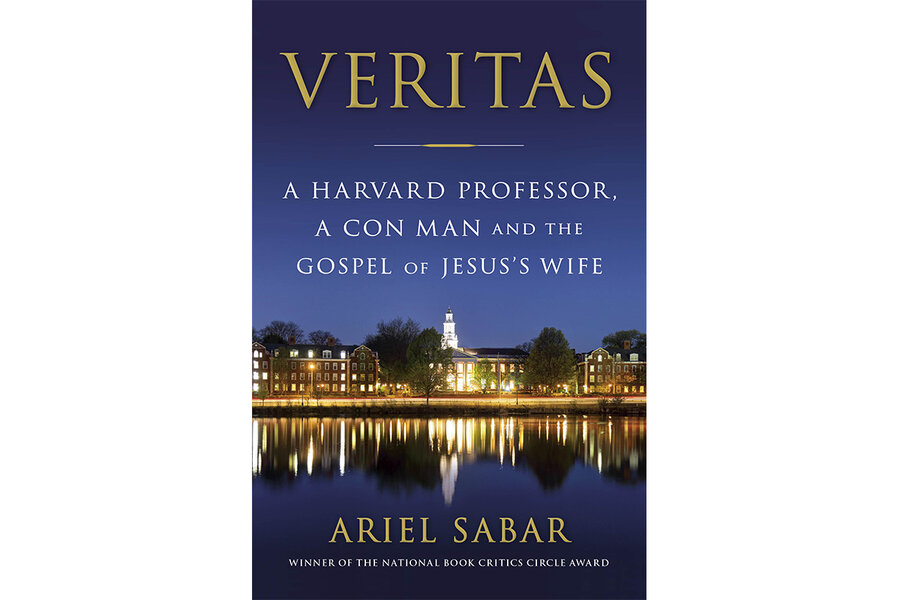The papyrus, the professor, and a scandal that ensnared Harvard Divinity School
Loading...
The story made international headlines in 2012. During an academic conference on Egypt’s earliest Christians, a renowned feminist historian of Christianity announced a potentially momentous discovery: a second-century papyrus fragment, about the size of a business card, that suggested that Jesus and Mary Magdalene might have been married.
The magnitude of such a discovery, if verified, would be hard to overstate. It had the potential to upend many fundamental precepts of Roman Catholic dogma, from priestly celibacy to the role of women in the Church and in marriage. What began as a quiet gathering of scholars quickly morphed into an international media circus. News of the papyrus fragment spread like a brush fire around the globe, followed soon by strong and divided public reaction.
The story of that papyrus, and the bizarre events surrounding it, is the subject of “Veritas: A Harvard Professor, a Con Man and the Gospel of Jesus's Wife.” Author Ariel Sabar is an experienced journalist. Here he puts his considerable investigative chops to work and fashions a cautionary tale about experts and expertise that is minutely researched and thoroughly absorbing.
At the center of Sabar’s story is Karen King, the first woman to be named Hollis Professor of Divinity at Harvard Divinity School, the oldest endowed chair in the country. An internationally recognized scholar of biblical history, King is a specialist in non-canonical gospels, documents from the first centuries of Christian history that early Church fathers considered heretical and excluded from the New Testament. King’s career had been built on interpreting these apocryphal works, especially the Gospel of Mary, which she believed gave a more accurate understanding of the role of women in the founding of Christianity. What excited King the most about the newly discovered papyrus was that it described Mary not only as Jesus’s wife, but as his disciple, equal to his male followers.
An email in 2010 from someone unknown to her, but identifying himself as a papyrus collector, brought the fragment to King’s attention. He claimed it was one of several papyri he had purchased from another collector. Might she be interested? Initially, King brushed him off. Abruptly, a year later, apparently convinced of its authenticity, she got back in touch. Soon, the papyrus was donated to Harvard, a Smithsonian documentary was in the works and King was off to Rome to announce to the world the fragment that she had named, provocatively, “The Gospel of Jesus’s Wife.”
Questions about the authenticity of the papyrus surfaced immediately. Doubts were raised about everything from the perfectly square shape of the fragment and the modern-looking script to a grammatical error in the Coptic text. Many questioned the provenance of the papyrus and the identity of the anonymous donor, whose identity King guarded closely.
Sabar, who initially reported on the papyrus for Smithsonian magazine and later for The Atlantic, delves into these questions far more rigorously than did King herself. While an article on the fragment by King was spending its way through a slipshod peer review and into the pages of the prestigious Harvard Theological Review, Sabar was probing deeply into every nook, cranny and crevice of the fragment’s story, as well as the story of every person and every institution associated with it and with King.
The most extraordinary cranny he explores is the anonymous “papyrus collector,” who turns out to be one Walter Fritz, a German immigrant living in Florida. A habitual liar and schemer, Fritz had studied Egyptology in Berlin before dropping out and later worked briefly as director of the Stasi Museum, located in the former headquarters of East Germany’s notorious secret police. During the time he was corresponding with King about the papyrus, his primary source of income was making pornographic videos featuring his wife.
That all this information was ferreted out by Sabar and not by King is one of the many strange twists in this strange tale. For a historian at the top of her field, when it came to the papyrus, King displays not only an astonishing lack of interest in the real Fritz and the provenance of the papyrus, but a general disregard for scholarly rigor.
Sabar does an exemplary job of not only digging into every facet, and then some, of the story of Fritz and the long con he pulled on King and Harvard, but in digesting it all and synthesizing it into a comprehensible and exciting narrative. It’s a wild and educational ride. Along the way, readers learn about early Christian history, the vagaries of Copitic script and grammar, the place of papyrus in written communication, methods of dating antiquities, the psychology of the con artist and a great deal more.
Why was King susceptible to such a fraud? Had the papyrus proved authentic, it would have lent great support to feminist ideas she had spent much of her career promoting. An identity crisis at Harvard Divinity School and the desire to gin up some excitement around the venerable, if dusty, institution, may have played a part in papyrus drama, though both King and the university have refused to shed any light on the question. Despite the controversy, King is still the Hollis Professor of Divinity at Harvard.
Even if the author burrows a bit deep in the weeds in some of his research, the rewards for the reader are still great. In “Veritas,” Sabar turns a complex, esoteric story into a page turner, and reaffirms the adage that truth is stranger than fiction.








